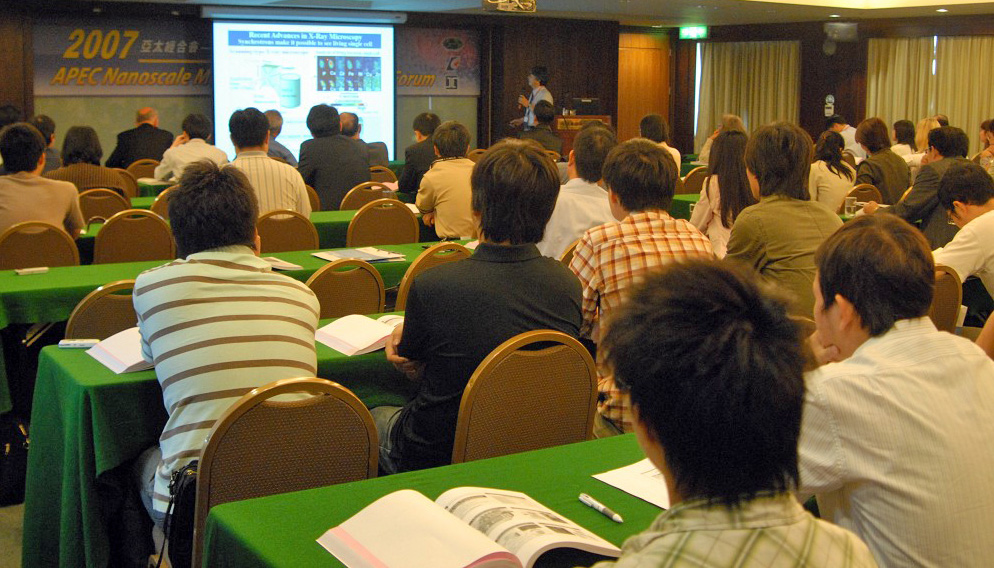Professor S. Putterman (University of California, Los Angeles, USA) and his colleagues recently demonstrated that simply peeling ordinary sticky tape in a moderate vacuum can generate sufficient X-rays to take an image of a human finger. The phenomenon has long been known as tribo-luminescence (or mechano-luminescence), but their report (including online video accessible from the Nature News page) has impressed many. Nanosecond, 100-mW X-ray pulses as well as radio and visible light have been clearly confirmed to be correlated with stick-slip peeling events. They observed a 15-keV peak in X-ray energy spectra, and attempted to explain it by various models. For more information, see the paper, "Correlation between nanosecond X-ray flashes and stick-slip friction in peeling tape", C. G. Camara et al., Nature, 455, 1089-1092 (2008), and the news article, "Sticky tape generates X-rays - How weird is that?", Katharine Sanderson, Nature News, http://www.nature.com/news/2008/081022/full/news.2008.1185.html as well as readers' comments thereon. A very old and pioneering report describing how peeling tape can be a source of X-rays is "Investigation of electron emission on tearing away highpolymer film from glass in vacuum", V. Karasev et al., Doklady Akademii Nauk SSSR, 88, 777-780 (1953).
October 2008 Archives
Dr. R. Fernandez-Ruiz (Universidad Autonoma de Madrid, Spain) recently published a theoretical paper on the expanded uncertainty associated with TXRF measurements. For more information, see the paper, "Uncertainty in the Multielemental Quantification by Total-Reflection X-ray Fluorescence: Theoretical and Empirical Approximation", R. Fernandez-Ruiz, Anal. Chem., 80, 8372-8381 (2008).
Chandrayaan-1 is the Indian Space Research Organisation's (ISRO) mission to the moon, with the main scientific objectives of photo-selenological and chemical mapping of the lunar surface. It was successfully launched from Satish Dhawan Space Centre, Sriharikota on October 22nd, 2008. The total mission is expected to last for two years. One of the most important activities is X-ray measurements by the Chandrayaan-1 X-ray spectrometer (C1XS). The primary goal of the C1XS instrument is to carry out high-quality X-ray spectroscopic mapping of the Moon, in order to constrain solutions to key questions on the origin and evolution of the Moon. C1XS will use X-ray fluorescence spectrometry (1.0-10 keV) to measure the elemental abundance, and map the distribution, of the three main rock-forming elements: Mg, Al and Si. To record the incident solar X-ray flux at the Moon, which is needed to derive absolute lunar elemental surface abundances, C1XS also includes an X-ray Solar Monitor (XSM), which is provided through collaboration between the Rutherford Appleton Laboratory (RAL) and University of Helsinki. With its wide field-of-view of ± 52 degrees, XSM provides observation of the solar X-ray spectrum from 1-20 keV with good energy resolution and fast spectral sampling at 16 s intervals. The total mass of C1XS and XSM is 5.2 kg. For more information about Chandrayaan-1, visit the Web page, http://www.isro.org/chandrayaan/htmls/Home.htm Wikipedia gives further info as well, http://en.wikipedia.org/wiki/Chandrayaan-1
Our lab signed a Memorandum of Understanding (MOU) for research collaboration on the "nanotechnology-driven advanced materials metrology research, X-ray physics and its industrial metrology applications, nanoscale materials characterizations" with Center for Measurement Standards (CMS), Industrial Technology Research Institute (ITRI), Taiwan. The two institutions agreed to promote exchanges of researchers, information, publication of the results of the research and/or the implementation of cooperative research. Both sides are interested in developing and establishing novel advanced metrology as well as the international standardization in Asia-Pacific region.

The significance of the collaboration between NIMS and ITRI was first discussed during the 2007 APEC Nanoscale Measurement Technology Forum, held in Taipei, September, 2007. Dr. Kenji Sakurai (NIMS, Group Leader, Quantum Beam Center) gave an invited lecture on X-ray metrology for nanotechnologies there.
The joint recipients of the 3rd Asada Award, which is presented in memory of the late Professor Ei-ichi Asada (1924-2005) to promising young scientists in X-ray analysis fields in Japan, are: Dr. Shuji Maeo (Osaka Electro Communication Univ., "Development of multi excitation type X-ray tube") and Dr. Hajime Tanida (Japan Synchrotron Radiation Institute, SPring-8, "Instrumentation on total-reflection XAFS for liquid-liquid interface studies"). The ceremony was held during the 44th Annual Conference on X-Ray Chemical Analysis, Japan, at Japan Women's University, Tokyo.
X-ray fluorescence (XRF) spectra for a number of rock samples from Mars, the Moon, and Mercury have been measured at the Physikalisch-Technische Bundesanstalt (PTB) beamline in the BESSY II electron storage ring. In the future, both ESA and NASA will send spacecraft to Mercury. Remote X-ray sensing is planned to obtain chemical composition mapping on the planetary surface. The present synchrotron XRF spectra will be used as valuable reference for the analysis. For more information, see the paper, "Measuring and Interpreting X-ray Fluorescence from Planetary Surfaces", A. Owens et al., Anal. Chem., 80, 8398-8405 (2008).
A research group at Lawrence Livermore National Laboratory recently reported an interesting application of ultrafast X-ray spectrometry to studies on the compression and heating of shocked matter. Here, the sample is 300 μm thick LiH, which is heated by a 450 J nsec laser, and the X-ray used is Ti Kα X-ray fluorescence (4.51 keV) from Ti foil heated by another pulse laser of 5 psec. X-ray photons produced at the Ti foil are estimated as a 2 × 1013/pulse. The energy spectra of X-ray scattering by the LiH sample during compression were taken by a spectrometer consisting of a large curved graphite (HOPG) crystal in van Hamos geometry and an Imaging Plate (IP) detector. It was found that the X-ray scattering spectrum from shocked LiH shows elastic Rayleigh scattering and inelastic plasmon scattering features. Whereas earlier in time only elastic scattering was observed, at 7 nsec, a plasmon energy shift of 24 eV was detected. This indicates the transition to metallic free electron plasma in the solid phase. For more information, see the paper, "Ultrafast X-ray Thomson Scattering of Shock-Compressed Matter", A. L. Kritcher et al., Science, 322, 69 -71 (2008).





